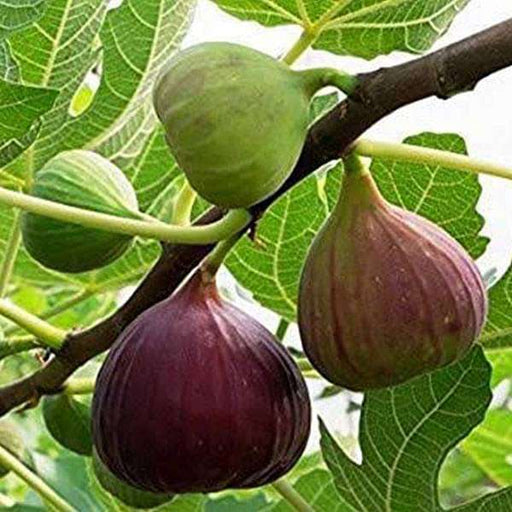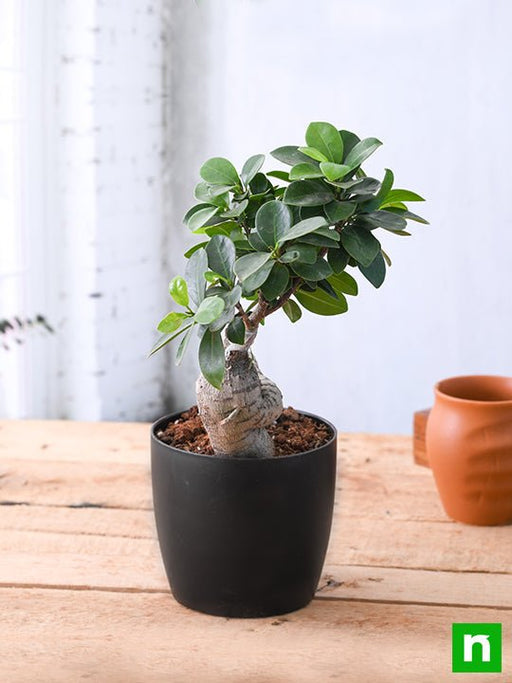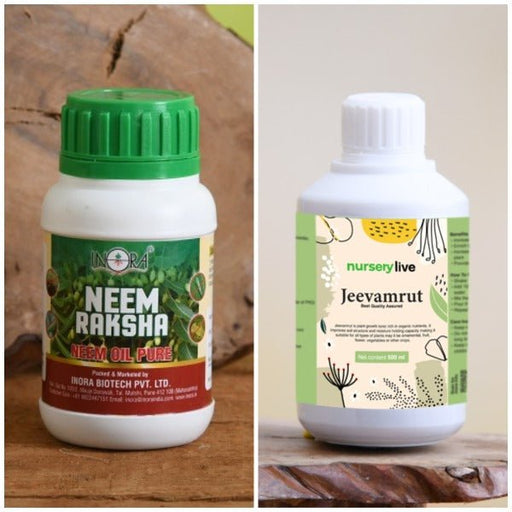
Banyan tree Bonsai - Plant
(MRP Inclusive of all taxes)
- Shipping ₹79 for entire order
- Dispatch in 7 days
- Country of origin: India

(MRP Inclusive of all taxes)

 Save 19%
Save 19%
Ficus Lyrata Bambino, Dwarf Fiddle Leaf Fig - Plant The Ficus Lyrata Bambino, commonly known as the Dwarf Fiddle Leaf Fig, is a stunning h...
View full details
 Save 26%
Save 26%
Creeping Fig Plant, Ficus pumila The Creeping Fig, scientifically known as Ficus pumila, is a versatile and resilient climbing plant nativ...
View full details Save 17%
Save 17%
Fig Tree, Anjeer Fruit, Common Fig Fruit - Plant The Fig Tree, scientifically known as *Ficus carica*, is a deciduous tree that produces t...
View full details
 Save up to 29%
Save up to 29%
Rubber Tree, Rubber Plant, Ficus elastica (Small) - Plant The Rubber Tree, scientifically known as Ficus elastica, is a stunning indoor plant that...
View full details
 Save 16%
Save 16%
Ficus Bonsai - Plant The Ficus Bonsai is a captivating miniature tree that brings a touch of nature's elegance into your home or office. K...
View full details
 Save 17%
Save 17%
Rubber Tree, Rubber Plant, Ficus elastica The Rubber Tree, scientifically known as Ficus elastica, is a stunning indoor plant renowned for...
View full details
 Save 23%
Save 23%
Rubber Tree, Rubber Plant, Ficus elastica (Black Prince, Burgundy) The Rubber Tree, scientifically known as Ficus elastica, is a stunning ...
View full details Save 15%
Save 15%
Pack of Vermicompost and Neem Cake for House Plants Transform your indoor garden with our premium Pack of Vermicompost and Neem Cake, spec...
View full details
Pack of Plant Growth and Flower Boosters Unlock the full potential of your garden with our Pack of Plant Growth and Flower Boosters! This ...
View full details Save 38%
Save 38%
Combo of Jeevamrut and Neem Raksha for Easy Growth and Protection of Houseplants Transform your indoor garden with our exclusive combo of ...
View full details Save 22%
Save 22%
Plant Nutrients Kit (Pack of 16) for a Healthy Garden Transform your garden into a lush paradise with our Plant Nutrients Kit, featuring 1...
View full details Save 16%
Save 16%
Combo of Top Plant Fertilizers Elevate your gardening game with our exclusive Combo of Top Plant Fertilizers, featuring two bags of premiu...
View full details Save 24%
Save 24%
Pack of 4 Additives to Make Soil Healthy and Nutrient Rich Transform your garden into a thriving ecosystem with our Pack of 4 Additives de...
View full details Save 30%
Save 30%
Transform your gardening experience with our premium Combo of Perlite and Vermiculite. This unique blend is designed to enhance soil aeration and ...
View full details Save 27%
Save 27%
Combo of 2 Vermicompost and Cocopeat - Enrich Your Soil Naturally! Transform your garden into a thriving ecosystem with our Combo of 2 Ver...
View full details
 Save 35%
Save 35%
Best 6 Plants for Perfect Indoor Garden Transform your living space into a lush oasis with our curated collection of the Best 6 Plants for a...
View full details
 Save up to 50%
Save up to 50%
Mini Succulent Garden Pack Transform your space with our Mini Succulent Garden Pack, featuring a delightful collection of 4 any variety beautiful s...
View full details
 Save 30%
Save 30%
5 Best Fragrant Plants Transform your garden or indoor space into a fragrant paradise with our curated selection of the 5 Best Fragrant Plants. Th...
View full details
 Save 24%
Save 24%
Set of 2 Bonsai Looking Grafted Adeniums Transform your indoor or outdoor space with our exquisite Set of 2 Bonsai Looking Grafted Adenium...
View full details Save 45%
Save 45%
Top 4 Die Hard Succulents Pack Transform your indoor or outdoor space with our Top 4 Die Hard Succulents Pack, featuring a curated selecti...
View full details
 Save 30%
Save 30%
5 Best Indoor Plants Pack Transform your living space into a lush oasis with our '5 Best Indoor Plants Pack.' This carefully curated collection fe...
View full details
 Save 25%
Save 25%
Set of 4 Evergreen Air Purifier Plant Pack Transform your indoor space into a lush, green oasis with our Set of 4 Evergreen Air Purifier Pla...
View full details| SrNo | Item Name |
|---|---|
| 1 | Banyan tree Bonsai - Plant |
The Banyan Tree Bonsai is a stunning miniature representation of the majestic Ficus benghalensis, known for its sprawling branches and aerial roots. This unique bonsai captures the essence of nature's grandeur in a compact form, making it a perfect addition to any home or office. With its lush green leaves and intricate root system, the Banyan Tree Bonsai not only enhances your space but also promotes tranquility and mindfulness.
What makes the Banyan Tree Bonsai special is its rich cultural significance and adaptability. Revered in many cultures, particularly in India, the Banyan tree symbolizes immortality and wisdom. Its ability to thrive in various environments makes it an ideal choice for both novice and experienced bonsai enthusiasts.
One of the standout features of the Banyan Tree Bonsai is its unique aerial roots, which can be trained to create stunning visual effects. These roots can be encouraged to grow downwards, giving the bonsai a distinctive and captivating appearance. This plant not only serves as a beautiful decorative piece but also as a living testament to nature's resilience.
The Banyan tree plays a crucial role in its ecosystem, providing habitat for various species and improving air quality. As a bonsai, it serves as a reminder of the importance of preserving nature and biodiversity in our urban environments.
Caring for your Banyan tree bonsai is like raising a tiny, leafy child. It requires attention, love, and just the right amount of water. Too much, and you’ll drown it; too little, and it’ll be begging for a drink. Keep an eye on humidity and light, and your little green friend will thrive, turning your living room into a mini rainforest.
The world of bonsai styles is as diverse as a box of chocolates. From the classic upright to the whimsical cascading style, your Banyan tree can take on many personalities. Choose wisely, as each style tells a story—whether it’s a majestic elder or a cheeky little sprite, your bonsai will be the talk of the town.
The right soil is the foundation of your bonsai’s happiness. Think of it as the cozy bed where your Banyan tree dreams of growing tall and mighty. A well-draining mix will keep the roots happy and prevent them from drowning in their own ambitions.
Pruning your Banyan tree bonsai is like giving it a stylish haircut. Snip here, trim there, and suddenly it’s a masterpiece! Regular pruning encourages growth and keeps your bonsai looking sharp. Just remember, less is more—no one wants a bonsai that looks like it lost a fight with a hedge trimmer.
Feeding your bonsai is essential, but don’t go overboard! Think of fertilizer as a gourmet meal for your little tree. A balanced diet will keep it healthy and vibrant, while too much can lead to a tree that’s more “overfed” than “well-fed.”
Want to expand your bonsai family? Propagation is the way to go! It’s like cloning your favorite tree, but without the sci-fi drama. With a little patience and the right techniques, you can create a whole forest of mini Banyans to share with friends or keep all to yourself.
Watering your bonsai is an art form. Too little, and it’s a desert; too much, and it’s a swamp. Finding that sweet spot is crucial. Use your finger to check the soil—if it’s dry, it’s time for a drink. If it’s soggy, hold off on the watering can.
should your Banyan tree bonsai live indoors or outdoors? Indoor trees bask in the glow of your love (and artificial light), while outdoor trees soak up the sun and fresh air. Choose wisely, as each environment offers unique challenges and rewards.
Show off your bonsai like the proud parent you are! The right display can elevate your Banyan tree from a mere plant to a stunning centerpiece. Consider a stylish pot and a strategic location that highlights its beauty—after all, every tree deserves its moment in the spotlight.
Pests are the uninvited guests at your bonsai party. From aphids to spider mites, these little critters can wreak havoc on your beloved tree. Regular inspections and a bit of preventative care will keep your Banyan tree pest-free and thriving, ensuring it remains the belle of the bonsai ball.
Beyond their aesthetic appeal, Banyan tree bonsais offer a plethora of benefits. They purify the air, reduce stress, and bring a touch of nature indoors. Plus, they’re a great conversation starter—who wouldn’t want to chat about their miniature tree that’s older than some civilizations?
A Banyan tree Bonsai is a miniature version of the majestic Banyan tree, known for its aerial roots and sprawling branches. It’s like having a tiny jungle in your living room, minus the mosquitoes and wild animals. Perfect for those who want to feel like a nature god without the hassle of a full-sized tree!
Caring for your Banyan tree Bonsai is like nurturing a diva. It loves bright, indirect sunlight and a well-draining soil mix. Water it when the top inch of soil feels dry, but don’t drown it! Prune those unruly branches to keep it looking fabulous and to maintain its bonsai shape.
Absolutely! Your Banyan tree Bonsai can thrive indoors, provided it gets enough light. Place it near a window where it can soak up some sun, but avoid direct rays that could scorch its leaves. Just remember, it’s not a houseplant; it’s a miniature masterpiece that deserves the best!
A well-draining potting mix is the secret sauce for your Banyan tree Bonsai. Look for a blend that includes akadama, pumice, and lava rock. This mix allows for proper drainage while retaining just enough moisture to keep your little tree happy. Think of it as a spa day for your roots!
Watering your Banyan tree Bonsai is like a dance: too little and it wilts, too much and it drowns. Check the top inch of soil; if it’s dry, it’s time for a drink. Generally, watering once a week is a good rule, but adjust based on your home’s humidity and temperature.
Fertilizing your Banyan tree Bonsai is like giving it a gourmet meal. During the growing season (spring and summer), use a balanced fertilizer every 4-6 weeks. In fall and winter, let it fast a bit. Just remember, too much fertilizer can lead to a tree that’s all show and no substance!
Pruning your Banyan tree Bonsai is an art form. Use sharp, clean scissors to snip away unwanted branches and leaves. Aim for a balanced shape and encourage new growth. Think of it as giving your tree a stylish haircut—just don’t go too wild, or it might end up looking like a punk rocker!
Yes, you can propagate your Banyan tree Bonsai! Take cuttings from healthy branches and place them in water or moist soil. With a little patience and care, you’ll have new little trees sprouting in no time. It’s like creating your own bonsai army, ready to take over your home!
Your Banyan tree Bonsai can attract pests like aphids and spider mites. Keep an eye out for tiny critters and webbing. If you spot them, a gentle spray of insecticidal soap or neem oil will send them packing. Think of it as your tree’s personal bodyguard against unwanted guests!
Growing a Banyan tree Bonsai is a journey, not a race. Depending on the care and conditions, it can take several years to achieve that perfect look. Patience is key! Just remember, good things come to those who wait—like a beautifully shaped bonsai that’ll impress all your friends.
Yes, your Banyan tree Bonsai can enjoy the great outdoors! Just make sure to acclimate it gradually to prevent shock. It loves bright, indirect sunlight, but avoid harsh winds and extreme temperatures. Think of it as a vacation for your tree—just don’t forget to bring it back inside when the weather turns!